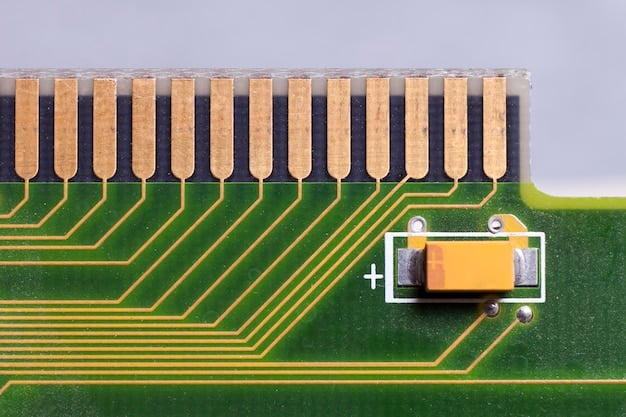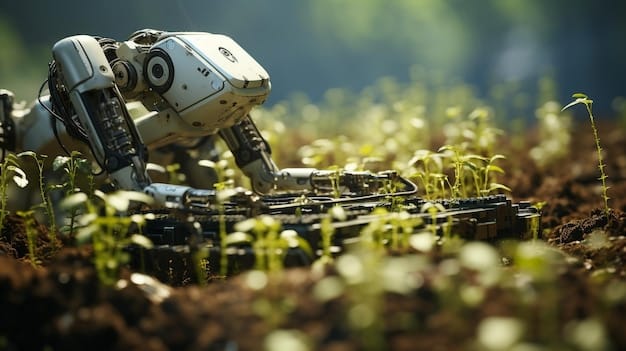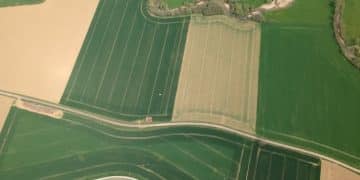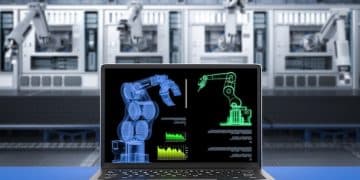AI in US Agriculture: Efficiency vs. Job Losses?

AI is revolutionizing US agriculture, promising increased efficiency through automation and data analysis, but raising concerns about potential job displacement for farmworkers.
The integration of artificial intelligence (AI) into various sectors is rapidly transforming industries worldwide, and US agriculture is no exception. This technological shift presents both exciting opportunities and significant challenges, as how AI is transforming US agriculture: increased efficiency or job losses? becomes a pressing question for farmers, policymakers, and workers alike.
Ai Driven Precision Farming How It Works
AI-driven precision farming represents a significant leap forward in agricultural technology. This approach leverages data analysis and machine learning to optimize various aspects of farming, from planting to harvesting. By understanding the intricacies of precision farming, one can better appreciate the transformative potential of AI in modern agriculture.
Data Collection and Analysis
The foundation of precision farming lies in the collection and analysis of vast amounts of data. Sensors, drones, and satellites gather information about soil conditions, weather patterns, and crop health. This data is then processed using AI algorithms to identify patterns and make informed decisions.
Automated Irrigation and Fertilization
AI enables farmers to automate irrigation and fertilization processes, ensuring that crops receive the precise amount of water and nutrients needed for optimal growth. This not only reduces waste but also minimizes environmental impact by preventing over-application of resources.

- Yield Optimization: AI algorithms analyze data to identify areas where crop yields can be improved, enabling farmers to implement targeted strategies.
- Resource Efficiency: By optimizing the use of water, fertilizers, and pesticides, AI helps farmers reduce costs and minimize environmental impact.
- Real-Time Monitoring: AI-powered systems provide real-time monitoring of crop health, allowing farmers to detect and address issues before they escalate.
- Predictive Analytics: AI can predict potential problems, such as pest infestations or disease outbreaks, allowing farmers to take proactive measures.
AI-driven precision farming is poised to revolutionize US agriculture by enabling farmers to make more informed decisions, optimize resource use, and improve crop yields. However, the adoption of these technologies also raises important questions about the future of agricultural labor and the need for workforce retraining.
The Automation Of Agriculture And Job Displacement
One of the most pressing concerns surrounding the adoption of AI in US agriculture is the potential for job displacement. As AI-powered machines and systems become more capable, the need for human labor in certain agricultural tasks diminishes.
Impact on Farmworkers
Farmworkers, who often perform physically demanding and low-paying jobs, are particularly vulnerable to job displacement due to automation. Tasks such as planting, harvesting, and weeding can now be performed more efficiently by robots and AI-driven machines.
Economic Consequences
The displacement of farmworkers can have significant economic consequences for individuals, families, and communities that rely on agricultural labor. Loss of income can lead to increased poverty rates and reduced access to essential services.
The rise of automation in agriculture raises valid concerns about job displacement, particularly for farmworkers. Understanding the extent and nature of this displacement is crucial for developing policies that mitigate its negative impacts and support affected workers.

Benefits Of Ai In Us Agriculture
Despite concerns about job displacement, AI offers numerous potential benefits for US agriculture. These benefits include increased efficiency, improved crop yields, and reduced environmental impact.
Increased Efficiency
AI-powered systems can perform agricultural tasks more quickly and efficiently than human labor. This can lead to increased productivity and reduced costs for farmers.
Improved Crop Yields
By optimizing planting, irrigation, and fertilization, AI can help farmers improve crop yields and increase their overall profitability.
- Reduced Waste: AI helps minimize waste by ensuring that resources are used efficiently and crops are harvested at the optimal time.
- Enhanced Sustainability: By reducing the use of pesticides and fertilizers, AI promotes more sustainable agricultural practices.
- Data-Driven Decision Making: AI provides farmers with valuable insights that enable them to make more informed decisions about their operations.
The benefits of AI in US agriculture are undeniable, with the potential to transform farming practices and improve the sustainability and profitability of agricultural operations. However, realizing these benefits requires careful consideration of the potential social and economic impacts.
Challenges And Solutions For Ai Implementation
The successful implementation of AI in US agriculture is not without its challenges. These challenges include high initial costs, lack of infrastructure, and resistance to change.
High Initial Costs
The cost of implementing AI-powered systems can be prohibitive for many farmers, particularly small and medium-sized operations. This can create a barrier to adoption and limit the potential benefits of AI.
Lack of Infrastructure
Many rural areas lack the infrastructure needed to support AI-powered systems, such as high-speed internet and reliable power grids. This can hinder the deployment and operation of AI technologies.
Addressing the challenges of AI implementation requires collaboration between government, industry, and academia. By working together, stakeholders can develop strategies to overcome these barriers and ensure that AI is accessible to all farmers.
The Ethical Considerations Of Ai In Agriculture
As AI becomes more prevalent in US agriculture, it is important to consider the ethical implications of its use. These ethical considerations include data privacy, algorithmic bias, and the potential for increased inequality.
Data Privacy
AI-powered systems rely on vast amounts of data, raising concerns about data privacy and security. Farmers need to ensure that their data is protected and used responsibly.
Algorithmic Bias
AI algorithms can be biased, leading to unfair or discriminatory outcomes. It is important to ensure that AI systems are designed and trained in a way that minimizes bias.
- Increased Inequality: The benefits of AI may not be evenly distributed, potentially exacerbating existing inequalities in the agricultural sector.
- Environmental Impact: While AI can promote sustainable practices, it is important to consider the potential environmental impact of AI technologies, such as the energy consumption of data centers.
- Transparency and Accountability: It is important to ensure that AI systems are transparent and accountable, so that users can understand how decisions are made and who is responsible for the outcomes.
Addressing the ethical considerations of AI in agriculture requires a proactive approach that prioritizes fairness, transparency, and accountability. By carefully considering these ethical issues, stakeholders can ensure that AI is used in a way that benefits all members of society.
The Role Of Policy And Education
To ensure that AI is implemented in a way that maximizes its benefits and minimizes its risks, policymakers and educators have a critical role to play. Policies can help to address issues such as job displacement and data privacy, while education can help to prepare workers for the changing demands of the agricultural sector.
Government Support
Government can provide financial support for farmers to adopt AI technologies, as well as invest in infrastructure and educational programs.
Workforce Retraining
Educational institutions can develop training programs to help workers acquire the skills needed to work with AI-powered systems. This can help to mitigate job displacement and ensure that workers are able to participate in the changing agricultural economy.
The role of policy and education is crucial in shaping the future of AI in US agriculture. By working together, policymakers and educators can help to ensure that AI is used in a way that benefits all members of society.
| Key Point | Brief Description |
|---|---|
| 🚜 Precision Farming | AI optimizes planting, irrigation, and harvesting through data analysis. |
| 💼 Job Displacement | Automation may lead to job losses for farmworkers. |
| 🌱 Benefits of AI | Increased efficiency, improved yields, and reduced waste. |
| 🛡️ Ethical Concerns | Data privacy, algorithmic bias, and inequality need careful consideration. |
Frequently Asked Questions
▼
AI-driven precision farming involves using data analysis and machine learning to optimize various aspects of farming, like planting and harvesting, to improve efficiency.
▼
AI optimizes planting, irrigation, and fertilization by analyzing data to ensure crops receive the right amount of water and nutrients for optimal growth.
▼
Concerns include job displacement for farmworkers, high initial costs for AI implementation, and ethical issues like data privacy and algorithmic bias.
▼
Governments can provide financial support for farmers to adopt AI, invest in infrastructure like high-speed internet, and fund educational programs for workforce retraining.
▼
Ethical issues include data privacy, algorithmic bias potentially leading to unfair outcomes, and the risk of AI benefits not being evenly distributed.
Conclusion
The integration of AI into US agriculture is a double-edged sword, offering significant gains in efficiency and productivity while posing challenges related to job displacement and ethical considerations. A balanced approach that promotes innovation, supports affected workers, and addresses ethical concerns is essential for ensuring that AI transforms US agriculture in a way that benefits everyone.





